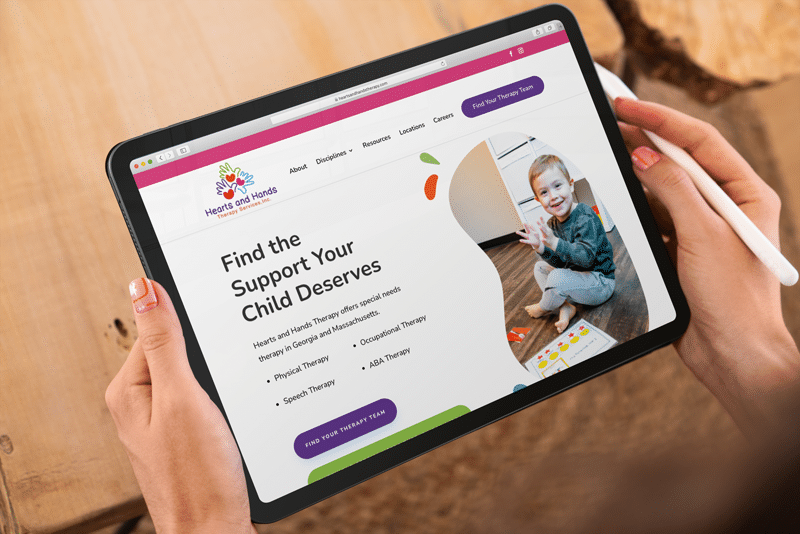Whether you’re looking to build your first website or go through a website redesign, you want to feel confident in the investment you’re about to make.
You want to ensure the dollars you spend and the time you and your team devote to website planning and development are used wisely.
It’s all too easy to get caught up in the details and required decision-making and lose track of the big picture–the results you expect your new website to deliver. Think sales, new leads, and greater awareness.
That’s why it’s key to focus on your website’s return on investment (ROI) from the very day planning begins.
Having a solid, strategic ROI plan allows you to understand how your investment in a new website will benefit your business, drive more income over time, and even gain internal buy-in to prioritize upgrading your website.
Now, let’s get specific.
Follow these ROI-boosting strategies to ensure your next website works as hard as you do for your business. (And if a new website isn’t on the horizon, you can also put this list to work to improve your current website’s ROI.)
1. Use a clear, direct call to action
Websites often fail to call people to action.
You can communicate your offerings and highlight why you’re the best company to hire, but if you don’t emphasize a specific call to action, you’re leaving money on the table.
You may think the calls to action on your website are obvious–people should click ‘contact us’ to move forward–but in reality, they’re not.
What does contacting you really mean? Will there be a call or meeting involved? Will they fill out a contact form and wait to hear from you?
Buyers want to know what to expect, particularly what to expect next.
A smart call to action directly calls out the action you want interested leads to take and fills them in on what will happen next, which lets them be better prepared when you interact and allows them to further understand if you could be the perfect fit to hire.
Here are examples of clear, direct calls to action:
- Schedule a consultation
- Get a quote
- Schedule a demo
- Choose a package
- Start a free trial
- Plan your visit
- Apply now
- Book a strategy session
- Sign up
Once you decide on your call to action, here’s the secret sauce that makes it even more effective: repeat it across your website.
That’s right, use the same call to action at the top of every webpage and throughout your website.
You don’t need to worry about getting too repetitive. Seeing your call to action multiple times will help prospects understand what they should do next if they want to engage with you. It erases any confusion and creates a clear path forward.
2. Clearly communicate what you do
Explaining what your company does on your website sounds simple enough, but we commonly see websites that lack clarity when it comes to explaining their services or products.
As an expert at what you do, it’s easy to use insider or vague language that leaves your prospects–often people who are not intimately familiar with your industry or offerings–confused.
And when you confuse, you lose, as Donald Miller, founder of StoryBrand, says.
If someone doesn’t understand exactly what you do upon visiting your website, they are likely to click away quickly. People won’t spend their precious mental calories trying to figure out if and how you can help them. Instead, they will turn to someone else.
It’s incredibly important to clearly and simply explain what you do.
Odds are, the language you use on your website could use some tweaking. If you’d like to refresh and simplify how you explain what you do, work through the StoryBrand framework to define your clear brand message. It’s the proven framework we use internally and for all of our clients to create clear messaging.
3. Create an engaging website experience
Once people visit your website, you want them to stick around.
The longer they last on your website, the more they learn about you and how you can help them. This translates to a higher rate of following your call to action, such as scheduling a call with you.
If you view your website analytics, you’ll see a bounce rate listed. Your website’s bounce rate shares how many people left your website after viewing only one page. It’s a metric you want to lower.
So how do you get website visitors to continue clicking through your website? By engaging them from the first webpage they interact with.
To start, make sure every webpage ends with a call to action.
You don’t want people scrolling through a page only to find themselves at a dead end. Once that happens, you leave what happens next up to them. Will they find another page to view? Or will they click away?
For example, a natural call to action on your About page could be to view your services. Your website visitor has learned about your business, and perhaps you and your team, and next they can follow up with learning more about what you do.
Offering a natural next step creates a turn-by-turn roadmap for website visitors.
It creates an experience, where prospective clients consume content and are directed to the next page that will offer value.
4. Go above and beyond to offer value
Many websites describe what they do, but they don’t go into detail. And detail is where buying decisions happen.
Now that you clearly describe what you do, it’s also important to share the why and how behind it.
Why is it critical for your ideal clients to prioritize your offering?
If you’re a home builder, this could look like: Why is it critical to work with a custom home builder?
If you’re a therapy clinic, this could look like: Why is it critical to focus on your mental health?
By explaining why it’s worth prioritizing your offering, you share the successful outcomes your target audience can reach, with you as their guide, and introduce the stakes or negative consequences that can occur to those who don’t take action.
Next, how does your offering work?
As highlighted earlier in this post, you want to clearly communicate the steps you clients take and what is involved in your offering.
Consider the following questions:
- How much time should they set aside to work with you? Are there regular calls or meetings?
- What process do you work through?
- When can clients expect to receive deliverables?
- Is it a one-time process or a long-term relationship?
By digging deeper into how your offering works, you play up the value of what you do and help warm leads determine if they want to pursue working with you.
5. Capture email addresses
Does your website help you build your email list?
If not, you’re missing out on an easy opportunity to gather names and contact information for prospective clients visiting your website.
The most effective method to gather email addresses involves offering something of value, often called an opt-in or lead magnet, in exchange for email addresses.
This opt-in offers greater value than the rest of your website content or what you share freely on social media. It’s helpful information that can only be accessed by sharing their name and email address.
Your opt-in can take a variety of forms, such as a downloadable PDF, video series, or quiz that offers a customized result. Once someone signs up for your opt-in, they are added to your email list, where you can communicate with them regularly by sending emails or newsletters to your subscribers.
Opt-ins are an essential element of sales funnels. They allow you to capture the attention of and engage with prospects, and then give you the opportunity to communicate with them directly in their inboxes.
6. Track analytics and react to what’s working (and what’s not)
Once your website is launched or refreshed, it’s easy to step away to focus on other priorities and ignore your website.
By proactively monitoring your website analytics, you can understand how your website performs. The more data you have on hand, the more power you have to respond to it.
Any issues that stand out, such as a high bounce rate (rate of people who leave your website after visiting one page), are addressable once you’re aware of them.
Analytics also show you the positives. If certain website pages or blog posts receive high traffic, then you can take that as a sign to create more content on those topics. Then you’re able to take advantage of the traction and build on it.
Based on your website’s performance, make sure to check in monthly to react to the data your website offers.
7. Build out a professional, on-brand design
Your web design brings your brand to life visually.
And while the content on your website is geared to connect with and convert your target clients, design also plays a major role in the first impressions your website receives.
Basic or outdated design can lead to perceptions that your brand is stagnant or behind. It opens the door for competitors to stand out through their web design.
If you haven’t invested in professional web design, now is the time.
The words you use on your website can only do so much of the heavy lifting. Colors, fonts, photography, graphics, and icons take your website to the next level, adding personality that subconsciously attracts your ideal clients.
8. Create a plan to drive traffic to your website
Your website can be set up for success, but if few people visit it, you’ll fail to see results.
Launching or tweaking your website doesn’t guarantee traffic will come. Instead, you have to be proactive in driving people to your website.
It starts by sharing valuable content on your website.
Blog posts, opt-ins, resources, portfolio work, case studies, and in-depth pages covering your offerings offer opportunities for your target audience to learn, better understand what you do, and identify if the solutions you provide are the right fit for them.
Buyers want to understand how your offering will help them survive and thrive. It comes down to basic human instincts.
When you link to helpful website content in your social media posts, newsletters, and sales conversations, you position your company as a trustworthy authority.
You also want to ensure your website is set up for search engine ranking.
Search engine optimization (SEO) funnels more traffic to your website. It allows you to tap into the searches prospective clients are already making online into your industry offerings.
And who doesn’t want more warm leads visiting their website?
By focusing on your website’s ROI, it’s easier to understand and justify the expenses that go in to building out, redesigning, or updating your website.
Your website is a powerful, and perhaps untapped, tool in your business toolbelt. It can help or hurt your ability to reach the right leads, prime them to want to do business with you, and convert them into paying clients.
By following these ROI strategies, you can expect to see greater results from your website that will boost your bottom line.





